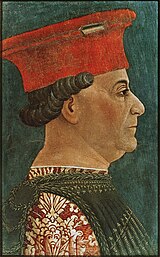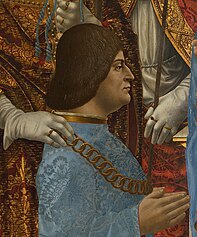Equestrian statue of Francesco Sforza
The equestrian statue of Francesco Sforza , also referred to as Cavallo di Leonardo , Il Cavallo or Sforza-Cavallo , was a planned but never executed equestrian statue for Francesco Sforza , which was to be erected in Milan around 1489 to 1500 . The statue was designed by Leonardo da Vinci from 1488/1489 on behalf of Ludovico Sforza (1452–1508), regent and later Duke of Milan.
Leonardo dealt intensively with the art form of sculpture only twice in his artistic career , with this equestrian statue and in 1511 with the monument of Gian Giacomo Trivulzio (Trivulzio grave monument). Both projects were never realized and never got beyond the planning and creation of models.
Historical background
Leonardo had entered the service of Ludovico Sforza in 1482 and stayed until 1499 when the troops of the French King Louis XII. Occupied Milan, in his service. He took the opportunity to commend himself to the Duke as a fortress engineer, weapons technician, architect, painter and sculptor as the bearer of a lyre he had built himself , a gift from his then patron Lorenzo de 'Medici .
Ludovico was the fifth son of Francesco Sforza (1401–1466) to succeed his father, who, as a successful condottiere and through his marriage to Bianca Maria, Filippo Maria Visconti's only daughter , had risen to become Duke of Milan. As the successor to his father, Ludovico intended to honor the work of the founder of the Milanese ruling dynasty, the Sforza, with a monumental equestrian monument.
Honoring rulers or founders of ruling dynasties with statues in public places is a tradition that had developed in Italy since the late Middle Ages. An early example in Milan itself is the statue of Podestà Oldrado da Tresseno placed in an arcade niche of the Palazzo della Ragione . Other examples of famous equestrian statues from 15th century Italy are the statues of the Condottieri Gattamelata (1447 by Donatello ) in Padua and Bartolomeo Colleoni (1493 by Andrea del Verrocchio ) in Venice.
The iconographic model for all artists and clients of the Renaissance was the life-size equestrian statue of Marc Aurel , which at that time still had its place in front of the Lateran Palace before Paul III. to Capitol Square , which was to be redesigned by Michelangelo. With the imperial pose of his rider, who dominates the powerfully striding mighty horse, it is the epitome of the strength, the power and the ability of the represented rider to lead a state. Also exemplary for the artists is the virtuosity of the art of antiquity, considered to be perfect, in capturing and representing nature, namely the human shape and physiognomy and, in the horse, especially the delicacy of muscle play and muscle tone.
Leonardo's project
First draft
In his letter of 1482, Leonardo suggested erecting a memorial to Ludovico's father, who died in 1466. The beginning of the work itself is evidenced by a document about the costs incurred, which were paid by the court official Marchesino Stanga. There is also evidence that Leonardo's workshop near today's Palazzo Reale was equipped with the necessary material for the production of a bozzetto . In his first draft, Leonardo envisaged a soaring horse, an ambitious concept that could not be realized with the knowledge of bronze casting at the time and that the Italian Pietro Tacca did not succeed until 1634/40 with his monument to Philip IV based on a painting by Velazquez .
Leonardo began thorough studies, drawing in detail the anatomy and movements of the horses in the ducal stables. Today much of these studies are kept in the Royal Library in Windsor . Leonardo's long-lost notebook with drawings and notes on the horses, the so-called Codex Madrid , was only rediscovered in the National Library of Madrid in 1965 . Leonardo's goal was to compose an ideal type as perfect as possible from the variety of noble horses. In his notes there are a number of comments in which he comments on the characteristics and qualities of individual horses. He paid particular attention to the dynamics of movement, a prerequisite for an expressive representation of a powerfully moving horse that does justice to the importance of the person to be honored.
Second draft
In April 1490, Ludovico seemed to have lost patience with Leonardo and tried to hire another sculptor to do the work. At this time, in the seventh year of his stay in Milan, Leonardo finally started to prepare a model under pressure from the Duke. According to Ludovico's plan, the monument should be completed at the time of his marriage to Beatrice d'Este in January 1491. At that time, however, Leonardo only had drafts to show.
On April 23, 1490, Leonardo wrote in his notes, he began work on the monument again. He discarded his first draft, decided to use the horse of one of the prince's bodyguards as a model and began new studies of proportions, new detailed anatomical drawings and calculations of material consumption and the technical implementation of the major project. Around 100 tons of bronze were estimated and provided for the casting. In the gardens at Palazzo Vecchio, a 7 m high 1: 1 clay model was created.
On the occasion of the engagement of Bianca Maria Sforza to the Roman-German King and later Emperor Maximilian I in November 1493, the solemn unveiling of the model took place, which the Milanese - they called the horse Il colosso - noted with amazement and admiration has been. At this point the model was ready to be cast in bronze. In the course of the campaign of Ludwig XII. through Italy, when the Estonians in Ferrara felt threatened by the French king, however, the bronze was transported to Ferrara and used to manufacture weapons.
On September 10, 1499, French troops under the command of Gian Giacomo Trivulzio invaded Milan, soldiers targeted Leonardo's horse and completely destroyed it. Only his drawings and notes bear witness to Leonardo's colossal equestrian statue .
Replicas in Italy
- The replica in the San Siro Hippodrome in Milan
In 1977 the American pilot and patron of the arts Charles Dent started a fundraising campaign to finance the casting based on Leonardo's designs and to donate it to the city of Milan. When Dent died in 1994, he had raised about 6 million US dollars, which his heirs contributed to the "Leonardo Da Vinci's Horse" foundation. The foundation commissioned the American sculptor Nina Akumu to create a clay model based on Leonardo's drawings. It was cast in the "Tallix Art Foundry" in New York, for technical reasons in seven separate parts and without the tab provided by Leonardo in his first draft.
In July 1999, 500 years after Leonardo's model was destroyed, the 15-ton horse arrived in Milan in seven separate parts. When assembled, it is 720 cm high. The American gift sparked a lengthy discussion in the city about an appropriate location. Today it is in the San Siro Hippodrome . ![]()
Since 2001 the “Cavallo Leonardo” has been the symbol of the MIFF International Film Festival, Milan.
- Replica in Vinci in Tuscany
On September 15, 2001, another replica of Nina Akumus was set up in the Piazza della Libertà in Vinci .
Replicas in the USA
A second replica based on the model made by Nina Akuma, dubbed The American Horse , was unveiled at Frederik Meijer Gardens in Grand Rapids , Michigan in October 1999 . The casting was financed by Frederik Meijer, the owner of an American supermarket chain, who also had a sculpture study center built in the neighborhood.
![]()
A third but smaller specimen based on the Akuma model was set up in October 2004 in Charles Dents hometown Allentown in the "Charles C. Dent Memorial Garden" of the "Baum School of Art".![]()
literature
- Maria Vittoria Brugnoli: Il Cavallo , in: Ladislao Reti (Ed.): Leonardo, artist, researcher, magician. Frankfurt: S. Fischer 1974, ISBN 3-10-042401-8 , pp. 86-109.
- Charles Nicholl : Leonardo da Vinci - The biography . S. Fischer, Frankfurt am Main 2006, ISBN 978-3-10-052405-8
- Milena Magnano. Leonardo . Milan 2008. ISBN 978-88-370-6432-7
- Franziska Windt, Joachim Poeschke : Andrea Verrocchio and Leonardo: collaboration in sculpture and painting . In: Contributions to the art history of the Middle Ages and the Renaissance , Vol. 11, Rhema-Verlag, Münster 2003. ISBN 3-930454-39-4
- I cavalli di Leonardo: studi sul cavallo e altri animali di Leonardo da Vinci dalla Biblioteca Reale nel Castello di Windsor . Exhibition Palazzo Vecchio , Florence. Catalog by Carlo Pedretti . Florence 1984.
Web links
- Il Cavallo di Leonardo esiliato a San Siro, Corriere della Sera, February 5, 2004
- Nina Akamu The American Horse, 1998
- The Re-Creation of Leonardo's Horse
Individual evidence
- ↑ a b Leonardo's letter to Ludovico Sforza, 1482
- ^ Dietrich Ebert: An extreme form of the personal political monument: The equestrian monument
- ↑ Magnano 2007. p. 23.
- ↑ Leonardo's Horse (Il Cavallo dello Sforza)
- ^ Rudolf Wittkower: La scultura raccontata da Rudolf Wittkower. Dall'antichità al Novecento , 1993.
- ↑ Nicholl, p. 323
- ↑ Magnano p. 149.
- ↑ Leonardo and the Horse , accessed May 12, 2019
- ^ The Modern Leonardo da Vinci's Horse DaVinci Science Center
- ↑ Leonardo and The Horse DaVinci Science Center, accessed May 12, 2019








